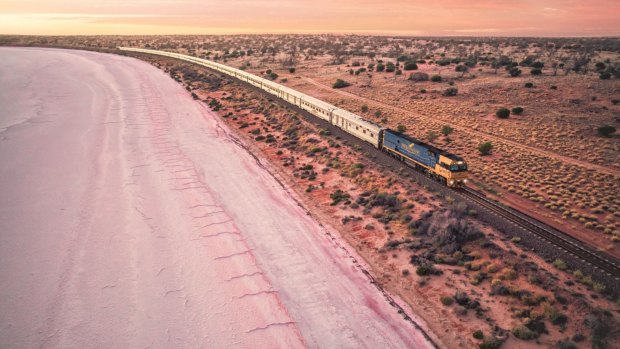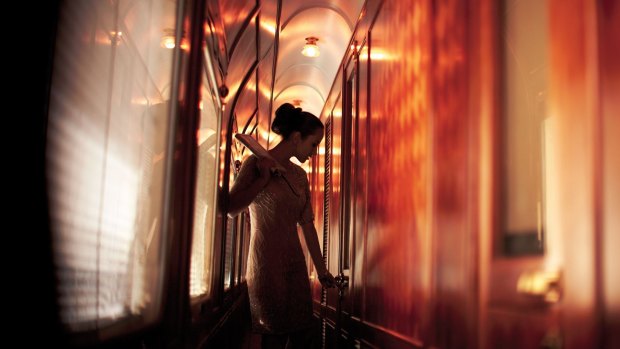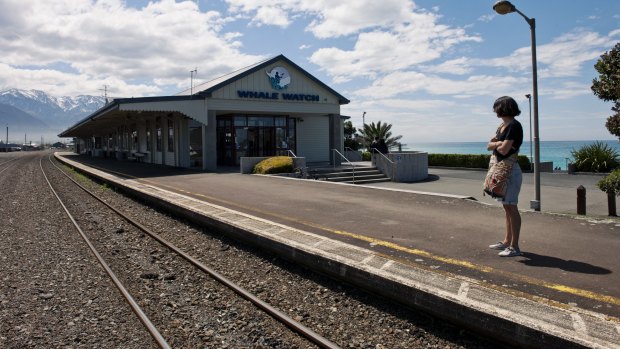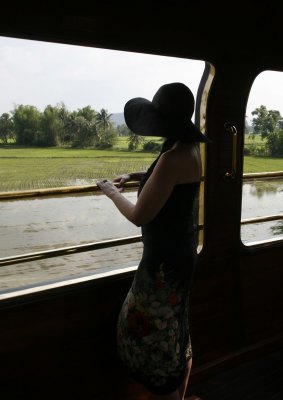This was published 5 years ago
Travel by train to slow down and reconnect with the world at your own pace
By Penny Watson

The Indian Pacific passing Lake Hart, a dry salt pan north of Woomera in South Australia.Credit: Getty Images
Don't confuse a train commuting experience with a great rail journey. One has your face in offensive proximity to a stranger's armpit, the other is an escapist journey through some of the world's most jaw-dropping scenery.
There are many reasons why train travel fits nicely with slow travel. For starters, you have someone up the front driving and navigating – you're not getting lost, facing peak-hour traffic or trying to find a carpark. This leaves you with plenty of time to sit back, relax, eat, drink, read and so on. But mostly it means you can look at the scenery. Each window frame is likely to be a new view, an ice-capped mountain as you come around a bend, a field of wildflowers, the striped greenery of wine country or a wave-washed beach. It's left to you to reflect, observe and take it all in.
Many of today's great train journeys are a nostalgic nod to the hedonism of the 1920s, with creature comforts and staff allowing you to really do nothing. But equally, cheap local trains are an opportunity to get an insider's angle on a destination. When my children were toddlers, my partner, Pip, and I had the impulsive idea of taking a family trip on Vietnam's Reunification Express train. The 1726-kilometre journey along the east coast starts in the north in Hanoi and ends about 33 hours later in Ho Chi Minh City.

The Eastern and Oriental Express is known as Asia’s most luxurious train.Credit: Getty Images
It travels at an average of 50 km/h, only slightly faster than in 1936, when it first journeyed along this path.
We had done this trip as young backpackers and the repeat journey with kids was a different experience, of course, but the ride was a slow-paced breather in the midst of a big travel adventure. Hazy blue mountains, beaches, sparkling water, nets and boats filled window frame after window frame. The tropical heat blustering through open windows. Hamlets of flat-roofed houses clustered along the railway line. Locals waiting on overloaded motorbikes for the boom gates to open. The smell of noodles and overripe bananas. The waft of dried fish. The side-to-side motion of the carriages.
Now, when I really want to put the brakes on routine and a hectic pace, a train journey is my default choice.

New Zealand’s Coastal Pacific service stops at the whale-watching town of Kaikoura.
THE GHAN AND INDIAN PACIFIC, AUSTRALIA
Norway has been playing around with slow TV for a decade, but Australia is just catching on to a trend that has been described, amusingly, as both boring and profound.
Taking the country by quiet storm in 2018, Australian broadcaster SBS hitched a GoPro onto the iconicGhan train and streamed the epic 2979-kilometre journey from Darwin in the north to Adelaide in the south.

An Eastern and Oriental passenger takes in the Thai countryside.Credit: Getty Images
The nexus of travel and technology captured the attention and accolades of the online audience, prompting SBS to produce a slow-TV version of that other great cross-country train trip, the Indian Pacific, which runs 4352 kilometres from Perth, on the Indian Ocean, to Sydney and the Pacific.
While the slow television is hypnotic, the reality is even more so. The Ghan trip takes 54 long, straight (mostly), mesmerising hours, spread over four days, with the pace quickening only when the train stops in the Top End at the outback town of Katherine, at Alice Springs (1500 kilometres from the nearest capital city), and eccentric mining town of Coober Pedy in South Australia, where inhabitants live in caves to escape the desert heat.
The Indian Pacific is already ticked off my bucket list. Its three-night, four-day journey involves 65 hours on the train, with stops in the outback mining centre of Broken Hill and, in stark contrast, Adelaide, famed for its surrounding wine regions. But it's the red-desert-dirt blur of the train crossing the Nullarbor Plain that I most remember. It is out there.
COASTAL PACIFIC, NEW ZEALAND
When the devastating Kaikoura earthquake hit New Zealand in 2016, the iconic Coastal Pacific rail journey was put on hold. Two years after the 7.8-magnitude shock, with restorations complete, the train is back on track and once again offers a sensationally scenic seaside journey.
The six-hour rail trip runs between Picton, in the Marlborough Sounds at the north of the South Island, and Christchurch on the east coast. Passengers can tilt their seat to enjoy views that take in 98 kilometres of rugged Pacific coastline, with the train passing within metres of the waves at some points.
You'll pass through Marlborough wine country and past iconic New Zealand vistas that combine brilliant green pastures and snow-capped mountain tops. The train track passes through 22 tunnels and crosses 175 bridges, including the Okarahia Viaduct, which arcs 21 metres above the beach. It's definitely Insta-worthy.
Stops include the whale-watching town of Kaikoura, dramatically placed between the base of the Kaikoura mountain range and the Pacific Ocean, and Blenheim wine country. The train departs from Christchurch each morning between December and April and returns from Picton each afternoon.
EASTERN AND ORIENTAL EXPRESS, THAILAND AND SINGAPORE
Cherrywood panelling, brass fittings and exquisite fabrics hint at the creature comforts on board the Eastern and Oriental Express. Passengers can also expect a turn-down service in their sleeper carriage, with slippers neatly placed under the bed.
This is one of the world's most exclusive trains. The two-night Bangkok to Singapore route takes in the lush tropical and rural landscape of Malaysia, with a stop at the traditional village of Labu Kubong, and a side trip in Thailand to the River Kwai, of World War II Burma Railway infamy.
Opt for a longer six-night journey
to savour stops including Malaysia's Cameron Highlands, a colonial tea plantation, and gorgeous Penang, with its multi-ethnic old town. The dining car is a white-tablecloth affair, with clinking glassware and low-lit table lamps. In the saloon car, choose a book or indulge in a 40-minute foot massage. Just don't miss too much of that palm-studded rural scenery.
Edited extract from Slow Travel (Hardie Grant) by Penny Watson, available now.
This article appears in Sunday Life magazine within the Sun-Herald and the Sunday Age on sale March 1.
Sign up for the Traveller Deals newsletter
Get exclusive travel deals delivered straight to your inbox. Sign up now.